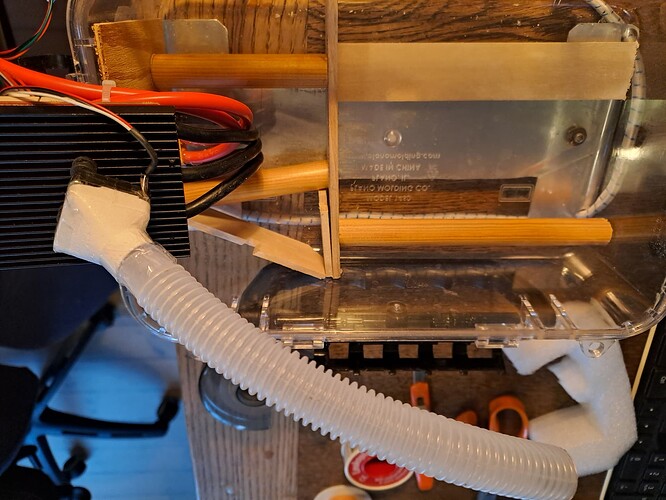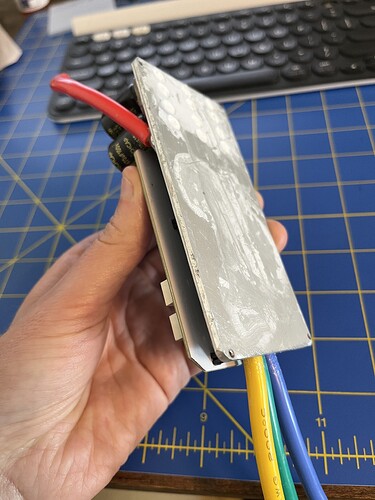12s4p battery (not sure about BMS/no BMS)
Flipsky 6384 waterproof 140kv motor
Flipsky 75100 pro v2 VESC
Flipsky VX3 pro remote
I’ll figure the rest later (box, etc)
I have a couple boards in my quiver to try (North 140L wing board, Naish 135L inflatable wing board, and a small 35L slingshot Alien Air kitefoil board)
My front wing is a 2000cm slingshot
I’m 90 kgs
The focus is to foil around our flat lake for short periods and hopefully start doing some ocean downwinders (once I gain some foiling skills).
Thoughts?
Good starter build, but I use the 75200 (works also without water cooling).
I started with 75100 and it overheated quickly, also considering you are heavier than me and you are also using a bigger front wing.
The bigger boards will get you easier on plane than the kite foil board if at all with such a small board ![]()
Maybe you also consider the Flipsky 7070 motor as it has little bit more torque.
Thanks Chris. I’ve heard using a 12S battery (mine will be 12s4p) keeps the heat down in the vesc. What battery setup were you running for the 75100? Also curious what cooling you implemented: water, radiator plate (fins) on the exterior of the box, passive in the box?
Also 12S4P but it depends on the cells you want to use. I used Samsung 40T3 which may run warm to hot only when run down to low voltage. I did only run passive cooling which was right about enough as the battery lasts roughly 35 to 40 minutes depending on riding style.
I’ve read a few times that guys would opt to bypass the BMS for discharge protection and just use for charging. Is the reason cost, space in the box, or does it screw up the delivery of power for the vesc/esc? If it’s the latter, is this possibly because the BMS specs were too limiting for the power draw? I haven’t been able to find this answer yet.
I believe that it’s absolutely important to implement some type of balancing during the charge cycle - how that accomplished has a pretty broad approach.
From the posts here a number of people have had some type of issue involving the BMS during discharge. That doesn’t mean that if implemented correctly that’s a BAD strategy just MORE complicated to implement and therefore more prone to issues occurring.
It would seem if you have a quality build battery pack the risk of having an issue where a BMS would need to intervene during discharge is small. If it’s not a quality BMS implemented correctly it might not even be capable of doing the job anyway so why increase complexity and cost is the question you should ask IMO. ![]()
Any experience with the 75100 pro v2 vs the 75200 pro v2 for my build? Chris, did you have your passive cooling through the box like in the foil drive+ box, or all in the battery box? I wonder if through box and the occasional water splash on the radiator is enough to keep this vesc cool enough for 1/2 hr foiling sessions. (maybe not since I’ll be falling a lot at the start?)
I appreciate you aren’t asking me the question but I did make a start at this by building a box on top of the board (that I already owned) type build.
My logic was to use possibly overrated and therefore possibly more expensive type of VESC for my build as I wanted to be able to or not be concerned about that essential component failing. When you think about it it’s the “brain” of the whole rig so not a good thing to have crash out.
Space constraints aside the weight and price differential of the two choices you mention are not very far apart.
Lots of posts here where people are choosing the absolute minimum VESC or ESC based on price or size where they smoke the “brain”. Try swimming a disabled board to shore once and you will think about doing it differently again. ![]()
I was thinking the 75100 pro v2 was playing the safe side. But now I’m not sure. I think it’s rated for 100 continuous/ 150 peak. Is there a post that delves into the amp draw for peak (takeoff) and for continuous (once up on foil). I saw one recently and now can’t find it.
It sounds like the 75200 pro v2 is just the safer option though to ensure I’m covered for heat isues
Well based on your stated use case… full Efoil at beginning on flat water - assume you are new to foiling and fairly big from a weight perspective means a LOT of demand on the components - Then out in big enough waves to foil assist but might need to power in if you get tired etc. and a top of the board box that isn’t severely space constrained as pure minimal foil assist would demand I would lean in the direction of a big VESC that won’t burn out quickly.
Investing in a higher end VESC would allow more flexibility if you decide to rebuild to full Efoil and is less likely to leave you stranded or broken down mid learning - that was my thinking but up to you to know what’s best for you.![]()
Appreciate the advice, I would rather overbuild than underbuild, so I’ve ordered the 75200 v2 pro. Any thoughts on a 3D-printed prop versus buying aluminum? 2-blade vs. 3-blade folding?
I’m not sure about prop choice for your motor although lots of posts here about.
From my perspective however it would seem reasonable that you start with a good non folding three blade as that would provide predictable low end thrust as you will likely be doing a lot of starts while learning.
I put all together in one waterproof box. Batteries on bottom ESC on top. If you do a lot of starts from zero you will get a hot box, but your total riding time is reduced anyway too. When you are more experienced and do maybe 2 to 3 water starts the total currents and thus heat dissipation gets kind of low. I also did not add a BMS but I added temperature sensors to my batteries. The VESCs typically also got a temp sensor built in and I think it was 80° where they kind of reduced power. So you dont want to get in this temperature zone.
So Chris, no hole cut in the box for the radiator fins to be cooled from outside air, nice. That sounds like good thermals. Glad you mentioned your heating issues before I went with the 75100. I wonder if a fan in the box would help with cooling or if moving hot air across the vesc would essentially do nothing
I have a fan on the ESC in the box. It helps a little. I was still experiencing temperature-based cut-off. A hose and air guiding around in the box improved the effect. Now the (ESC) temperature reaches 70c and no problems.
I have both of those and run both of those. I use the 75100 on my assist setups with the 6364 and 6384. Its never exceeded 80A (battery current) and once up tends to run about 20A unless I start carving heavily under power. I should also state that I was using a 24L board and am 95kg. I never had it overheat and out of all the components the battery was the warmest.
The 75200 I run on efoil. I’ve been lazy and haven’t bothered water-cooling it but its not overheated yet. The only thing I can say is that I havent been hammering the trigger like a used to a few years back.
heat sink on the side of the box with ESC glued through a hole is probably the easiest fix to any temperature issues. Without, I had ESC hitting high 90s, and once done cool to the touch, easy and effective
What did you use to waterproof the cut-through for the esc cooling? Has the system held up over time. Any reapplying of glue/epoxy needed or all still watertight?
Another way to cool an ESC is to add a liquid like CorrosionX or mineral oil or something similar to slosh around in the box. I have seen a few examples of this approach.
It’s a pretty simple way to help manage heat build up, but I imagine it’s messy when something goes wrong you go into the box and get things out.
I would personally lean towards the cut out method with an external heat sync glued onto the box. Probably with 3M 5200 marine adhesive and maybe some silicone as well around the edges.
This is a (dead) 75200 vesc removed from its outer casing. I would press the lower aluminum plate against the heat sync with a bit of thermal paste or glue. The outer case would be nothing but bulk and weight and would reduce the effectiveness of the outer heat sync. If thermal paste is used then some sort of clamp or screws would be needed to hold it in place (if it separates from the heat sync it will heat up and die).

